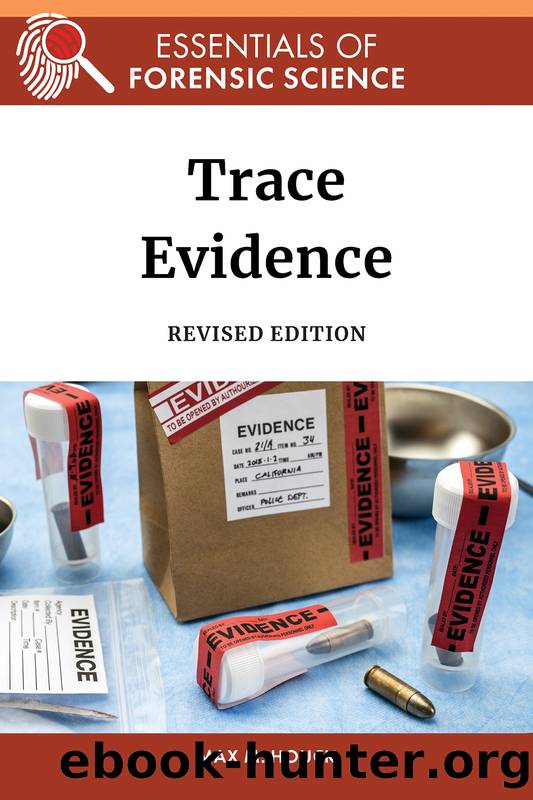Trace Evidence, Revised Edition by Infobase

Author:Infobase
Language: eng
Format: epub
Tags: Science&Technology
ISBN: 9781438182643
Publisher: Facts On File
Published: 2022-08-27T02:29:56+00:00
Different materials have different optical properties, like refractive index and birefringence. Using a PLM, a scientist can learn a little or a lot about almost every kind of material, from asbestos to zircon. Few scientists routinely use a PLM, however, probably because they have not learned how to use it properly or in routine work.
Fluorescence Microscopy
Besides conventional microscopy and the PLM, another method of microscopy that is useful in the analysis of forensic trace evidence is fluorescence microscopy. Like the PLM, a fluorescence microscope uses filters to select specific types of light that, when they interact with the sample, provide information. Fluorescence (as well as phosphorescence) is the luminescence of a substance excited by radiation. Phosphorescence is characterized by long-lived emission, like the luminous numbers and hands on a "glow-in-the-dark" watch face. Fluorescence, by contrast, is shorter lived; for instance, a white T-shirt glows in the presence of a black light but stops glowing when the light is turned off.
Luminescence occurs when radiation of high energy falls on a substance and excites it, infusing it with energy. The substance absorbs or converts a certain, small part of the energy (into heat, for example). Most of the energy that is not absorbed by the substance is emitted again. In fluorescence, the wavelength of the emitted energy is longer than that of the exciting radiation because the radiation has lost energy compared to the exciting radiation. Therefore, invisible radiation can cause a fluorescing substance to emit energy in the visible range, creating a colored glow. This is the basis of fluorescence microscopy.
In a fluorescence microscope, the specimen is illuminated with light of a short wavelengthâfor example, ultraviolet or blue; the specimen absorbs part of this light and reemits it as fluorescence. The wavelength of light is selected using a filter to channel only light of a specific wavelength; this is called the excitation filter. The fluorescence emitted is relatively weak compared with the strong illumination that caused it. To see the fluorescence, the light used to excite the sample is filtered out by a secondary filter placed between the specimen and the eye; this filter is called, for obvious reasons, a barrier filter. This filter, in principle, should be fully opaque at the wavelength used for excitation and fully transparent at longer wavelengths so as to transmit the fluorescence. The fluorescent object is therefore seen as a bright image against a dark background. A fluorescence microscope differs from a conventional microscope in that it has a special light source and a pair of complementary filters. The lamp is a powerful light source, rich in short wavelengths: high-pressure mercury arc lamps are the most common.
Fluorescence microscopy assists with discriminating between samples with similar but not the same characteristics, particularly dyes or colorants. Some materials respond differently based on the fluorescent chemicals in themâthe differences are seen as various colors and intensities.
Microscopy is a powerful technique for forensic scientists to use on the smallest possible evidence traces. It does require an understanding of optics and lenses, but the basics are not difficult to master.
Download
This site does not store any files on its server. We only index and link to content provided by other sites. Please contact the content providers to delete copyright contents if any and email us, we'll remove relevant links or contents immediately.
The Borden Murders by Sarah Miller(4276)
The Secret Barrister by The Secret Barrister(3661)
Police Exams Prep 2018-2019 by Kaplan Test Prep(2516)
Coroner's Journal by Louis Cataldie(2458)
The Splendid and the Vile by Erik Larson(2415)
Terrorist Cop by Mordecai Dzikansky & ROBERT SLATER(2051)
My Dark Places by James Ellroy(1910)
A Colony in a Nation by Chris Hayes(1901)
The Art of Flight by unknow(1840)
Black Klansman by Ron Stallworth(1767)
Objection! by Nancy Grace(1762)
A Life of Crime by Harry Ognall(1710)
The New Jim Crow by Michelle Alexander(1675)
American Prison by Shane Bauer(1642)
Anatomy of Injustice by Raymond Bonner(1641)
Invisible Women by Caroline Criado Perez;(1605)
Whoever Fights Monsters by Robert K. Ressler(1592)
Obsession (The Volkov Mafia Series Book 1) by S.E Foster(1557)
A is for Arsenic: The Poisons of Agatha Christie (Bloomsbury Sigma) by Kathryn Harkup(1525)
